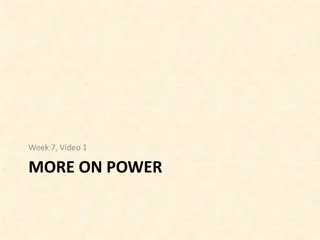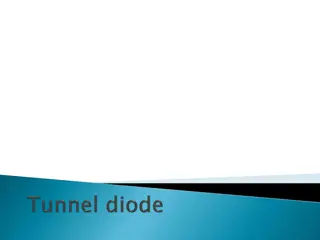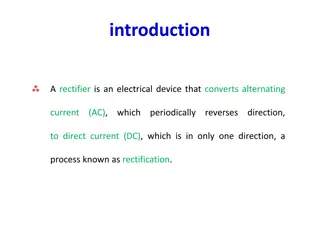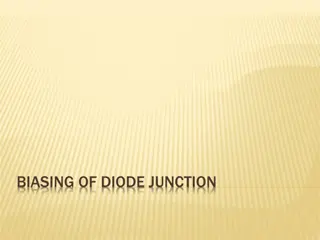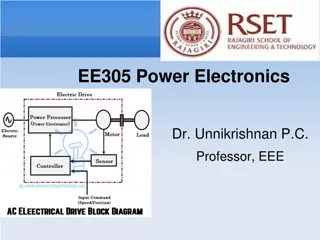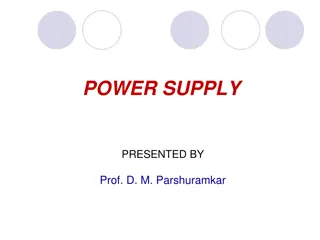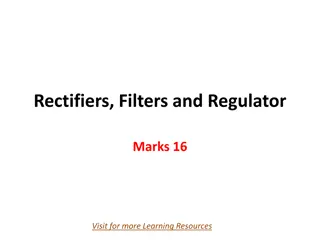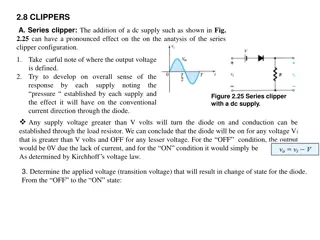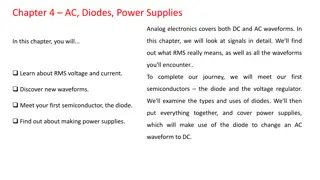Understanding Diode Circuits and Rectifiers for Power Supplies
Exploring the functionality of diode circuits in series and parallel configurations, along with clippers, clampers, and voltage multipliers. Gain insights into power supplies such as half-wave and full-wave rectifiers, Vrms derivation, Ripple Factor, and more. Learn about diode behavior in rectification, the concept of Peak Inverse Voltage (PIV), DC output characteristics, RMS value, Ripple Factor, and efficiency calculations. Dive into the design and operation of simple zener voltage regulators and DC power supplies.
Download Presentation

Please find below an Image/Link to download the presentation.
The content on the website is provided AS IS for your information and personal use only. It may not be sold, licensed, or shared on other websites without obtaining consent from the author. Download presentation by click this link. If you encounter any issues during the download, it is possible that the publisher has removed the file from their server.
E N D
Presentation Transcript
DiodeCircuits: Series and parallel diode circuits, Clippers, Clampers, Voltage multipliers. PowerSupplies: Half-wave and full wave rectifiers, Derivation of Vrms,Vdc, ripple factor, peakinverse voltage, rectificationefficiencyin eachcase Capacitorfilter. Working and design of a simple zener voltage regulator. Block diagram descriptionof a DCPower supply. PrincipleofSMPS
Used for converting AC to DC. Two types. Half wave rectifier-Getting output in the half cycle of the input signal. Full wave rectifier-Getting output in the full cycle of the input signal.
Peak Inverse Voltage (PIV) Maximum voltage the diode must withstand during the reverse bias half cycle of the input signal. PIV in HWR = Vm Disadvantages: Low output because only one half cycle delivers the output. AC components are more in the output.
DC Output The DC output voltage or a current of the rectifier is the average value of the output voltage or current.
In a half wave rectifier the load resistance RL=1K the forward resistance of the diode rd=100 , input alternating voltage (Vm) =325 volt. Find (a) Peak value, average value and rms value of the output current (b) Efficiency of the rectifier.
Full wave rectifiers are of two types, Centre tap rectifier Bridge rectifier
The purpose of the rectifier is to convert AC voltage to DC. But not type of rectifier converts AC to pure DC. It produces pulsating DC. This residual pulsation is called ripple. Ripple factor indicates the effectiveness of the rectifier in converting AC to perfect DC. It is the ratio of the ripple voltage to the DC voltage. For HWR , =1.21 For FWR, = .482
Efficiency of the rectifier is a measure of conversion of AC power to the useful DC output power. It is expressed as the ratio of DC output power to AC input power. For HWR, = 40.6 % For FWR, = 81.2 %
In a full wave centre tap rectifier, the load resistance used is of 2K,the forward resistance of each diode is 400 ,the voltage across the half of the secondary winding is 240 Sin50t.Find (a) Im, (b) Idc(c) Irms(d) ripple factor (e) PIV.
Parameters used to measure the performance of voltage regulator are line regulation and load regulation. Line regulation is the ratio of change in output voltage to the change in source voltage. Load regulation is defined as the ratio of change in output voltage to the change in load current.
Basic Concept Uses a series switching element that turns the current supply to a smoothing capacitor on and off. The time the series element is turned on is controlled by the voltage on the capacitor. If it is higher than required, the series switching element is turned off, if it is lower than required, it is turned on. In this way the voltage on the smoothing or reservoir capacitor is maintained at the required level.
Advantages High efficiency Compact Flexible technology Disadvnatages Noise Expert Design Required Costly
Clippers Clampers Multipliers
Series Negative Clipper Series Positive Clipper
Biased Series Negative Clipper Biased Series Positive Clipper
Positive Clipper Negative Clipper
Biased Positive clipper with Positive supply Biased Negative clipper with Negative supply
The clamping network is one that will clamp a signal to a different dc level. Clamping circuits are often used in TV receivers as dc restorers. Clamper Types Positive Clamper Negative Clamper Biased positive Clamper Biased Negative Clamper



